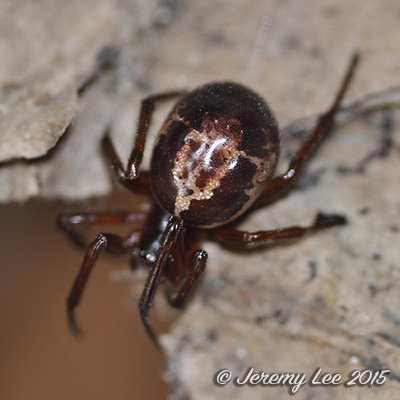
 |
|
Scientific Classifications explained » Amphibians » Ants » Aphids » Bees » Beetles » Birds » Bugs » Butterflies » Caterpillars » Damselflies » Dragonflies » Earwigs » Flies » Frog/Leafhoppers » Fungi » Galls » Grasshoppers » Harvestmen » Hoverflies » Lacewings » Ladybirds » Leaf Mines » Lichens » Mammals » Millipedes » Mosses » Moths » Sawflies » Slugs » Snails » Spiders » Trees & Shrubs » Wasps » Wild Flowers » Woodlice » Postboxes |
UK Nature > Spiders > Steatoda nobilis

Scientific Name: Steatoda nobilis Common Name: Noble False Widow Steatoda nobilis is a spider in the genus Steatoda, known in the United Kingdom as the noble false widow. As the common name indicates, the spider superficially resembles and can be confused with the black widow and other spiders in the genus Latrodectus, which can have medically significant venom. Steatoda nobilis is native to Madeira and the Canary Islands from where it allegedly spread to Europe, and arrived in England before 1879, perhaps through cargo sent to Torquay. In England it has a reputation as one of the few local spider species which is capable of inflicting a painful bite to humans, with most bites resulting in symptoms similar to a bee or wasp sting. Steatoda nobilis has a brown bulbous abdomen with cream coloured markings that are often likened to the shape of a skull. The legs are reddish-orange. Females range in size from about 9.5 to 14 mm in size, while males are 7 to 11 mm. The distribution of Steatoda nobilis is expected to increase northwards in the UK, due to, at least partly, mild winters in recent years. |
|

https://www.uknature.co.uk is a website dedicated to showing the immense diversity of UK nature and wildlife. Our vast range of habitats, from lowland arable to snow covered mountains, from storm-ravaged coastlines to peaceful inland freshwater lakes and rivers, from dry, sandy heaths to deciduous and coniferous forests, all these habitats contribute to the abundance of UK nature. We have wild birds in huge numbers either residing or visiting our shores (597 recorded species as at July 2013) and we must also not forget the humble back garden with its grass lawns, flower beds filled with nectar rich flowers, shrubs and trees, all designed to attract huge numbers of insects such as bees, moths, butterflies and hoverflies; and finally the small ponds which provide safe havens for frogs, toads, newts and even slow worms and grass snakes. www.uknature.co.uk is the showcase for my personal passion, photographing uknature in all its glory. I sincerely hope you all enjoy the fruits of my labours. This site and all images contained therein is © Jeremy Lee 2004 - 2025. All Rights Reserved. Site design by Jeremy Lee. Site development & IT Support by Stuart Lee. |